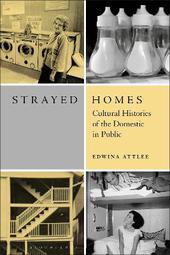
|
Strayed Homes: Cultural Histories of the Domestic in Public
Paperback / softback
Main Details
| Title |
Strayed Homes: Cultural Histories of the Domestic in Public
|
| Authors and Contributors |
By (author) Edwina Attlee
|
| Physical Properties |
| Format:Paperback / softback | | Pages:216 | | Dimensions(mm): Height 234,Width 156 |
|
| Category/Genre | Public buildings - civic, commercial, industrial, etc |
|---|
| ISBN/Barcode |
9781350213906
|
| Classifications | Dewey:725 |
|---|
| Audience | | Tertiary Education (US: College) | |
|---|
| Illustrations |
32 bw illus and 18 color illus
|
|
Publishing Details |
| Publisher |
Bloomsbury Publishing PLC
|
| Imprint |
Bloomsbury Visual Arts
|
| Publication Date |
29 June 2023 |
| Publication Country |
United Kingdom
|
Description
Poetic and political, Strayed Homes invites architects, interior designers, and urbanists to think again about common concepts in architecture - 'private', 'public' and 'home'. Whereas most writing about the public/private focusses on urban space, this book focusses on the domestic - exploring those overlooked, everyday places where private and intimate activities take place in public. With four chapters set in four small, liminal spaces: the launderette, the greasy spoon, the fire escape, and the sleeper train - the book is part architectural history, part cultural history. It follows a series of allusions and impressions, to explore how films, adverts, books and anecdotes shape experiences of everyday architecture. Making a case for the poetic interpretation of space, the book can be used as a sourcebook for architects, designers, and theorists alike - prompting the reader to rethink the emotional state of leaving home, intimacy in public, and lonely dreaming.
Author Biography
Edwina Attlee is Senior Lecturer in Critical and Contextual Studies at the Sir John Cass Faculty of Art, Architecture and Design and a Teaching Fellow at the Bartlett School of Architecture.
ReviewsStrayed Homes brings a valuable contribution on spaces as they're occupied and used; a type of enquiry that is rare in architectural history, which tends to be concerned predominantly with designers. It would make heartening reading for architects who feel stuck in regulations and requirements and would like to rediscover spaces as sites of practices, movements and memories; and for anyone who enjoys cultural history written with care and attention to the small details, anxieties and pleasures of life in buildings. * Architect's Journal *
|